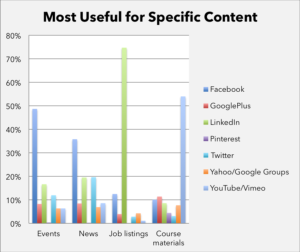
Understanding how to engage with social media and make it a useful tool that increases the reach and impact of your ATE project or center work is an ongoing process. Integrating social media tools into daily routines and practices takes time. So whether it’s using Facebook to connect with partners and colleagues, tweeting to support recruitment, or working with students to create their own LinkedIn pages, you want to know that your efforts will bear fruit.
Here at ATE Central we use social media primarily for outreach, and we’re always interested in understanding the best practices of these tools, particularly in educational environments. In 2012 ATE Central, in consultation with EvaluATE and the American Association of Community Colleges (AACC), conducted a survey of the ATE community to better understand how social media are being used and identify ways to use these technologies more effectively. The 2012 Social Media Survey (you can check out the full report here) built upon social media research done in 2010 by the ICTStudy.
About the Survey
The aim of the survey was to answer some fundamental questions about social media efforts and perceptions within the ATE Community, including:
- How plugged in to social media is the ATE community?
- Are Facebook, Twitter, YouTube, LinkedIn, and other social media services helping ATE projects and centers meet their goals?
- What can be done to make social media more useful for the ATE community?
The results of that survey were interesting - among the ATE community, current usage and perceived usefulness of most social media were low to moderate. While the ATE community’s perception of social media was that it was only slightly or moderately useful, most respondents felt that social media had the potential to be very or even extremely useful, and much of the ATE community reported that they were very interested in information, training, services, or tools that could help them use social media more effectively.
Armed with that information, and after discussions with community members, NSF, and our National Visiting Committee, the ATE Central team in collaboration with EvaluATE created the concept of an ATE community social media and technology audience survey. The consensus was that the more we collectively understood about all of our audiences’ use of social media, the better all of us in the ATE community could serve our individual audience member’s needs and connect with them using these tools.
Over the spring and summer of 2015 we worked collaboratively with the EvaluATE team and a group of project and center PIs to create the survey content and interface. Distributed in August, the first survey went out to over 17,000 potential participants, representing combined mailing lists from 12 ATE projects and centers.
We asked respondents information about how they use social media in their work and in educational settings – which tools they used most, which they found most useful, and how often they used them. We also queried audience participants about what technologies they used (smartphone, laptop, or tablet, for example) for sharing or accessing social media.
Preliminary Results
As we begin to sort through and analyze the data from the approximately 1,200 respondents, here are some preliminary highlights we’d like to share:
- Facebook is by far the most used (and perceived as most useful) by our audiences, followed by YouTube and LinkedIn
- The three social media channels above were the ones primarily used by our ATE audiences for work or in educational settings
- Facebook is perceived as most useful for news and events, LinkedIn for job postings, and YouTube for course materials
- Of ATE projects and centers who use social media, more than half have not assessed the effectiveness of their social media usage
- For those who have done assessment, most have used the tools embedded in the social media or have used audience surveys
It’s interesting to note that our findings for ATE audiences are similar to the data from the PEW Research Center’s Social Media Update 2014 – Facebook remains the most used platform, followed by LinkedIn. (PEW does not consider YouTube.) You can learn more about PEW data in an earlier post or go directly to the full PEW report. ATE Central and EvaluATE will be releasing a detailed report from the ATE audience social media survey, including a link to the full dataset, early in 2016.

 Subscribe
Subscribe


 See More ATE Impacts
See More ATE Impacts

Comments
There are no comments yet for this entry. Please Log In to post one.